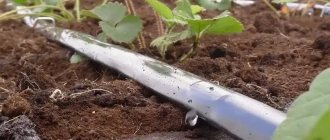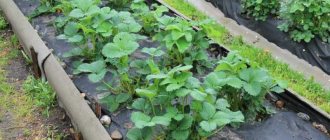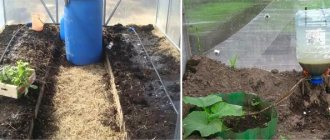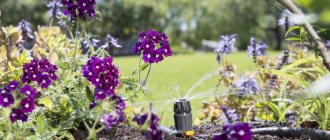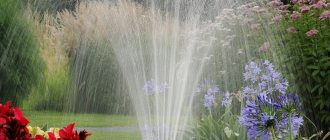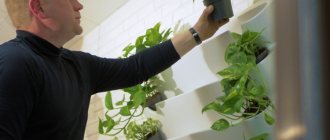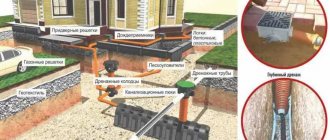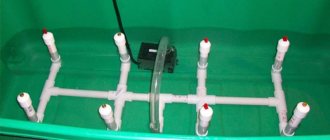There are many advantages to using drip irrigation for strawberries: there is no need to water the beds every evening; water consumption decreases; It is possible to uniformly apply fertilizer directly to the root system. If you have laid spunbond, the problem of regular weeding goes away. In this article we will look at the simplest methods with diagrams on how to assemble a system with your own hands without extra expenses. A real example of the installation of finished irrigation will also be considered.
DIY drip irrigation of strawberries with video
Strawberries are a rather demanding plant; they require constant care and painstaking actions. In addition to its “whims” regarding soil, fertilizers, etc., strawberries also require almost ideal conditions for providing moisture, because not only a lack of water, but also its excess has an undesirable effect on yield. But experienced gardeners solved this problem in an inventive way. They use drip irrigation for strawberries. It is this invention that we will pay attention to in this article, talking about the advantages of drip irrigation, and, most importantly, we will provide information on how to make the above-mentioned device for watering strawberries at home.
Proper watering of strawberries - what is it like?
Often in gardens and on personal plots you can see the following picture: the neighbor on the right has perfectly even rows, clean soil between the rows and bunches of strawberries glowing brightly in the sun against a background of dark greenery underneath. On the left, behind the fence, there is an alternation of weeds and stunted berry bushes, drooping single berries.
Or even soil without weeds, even rows - but the strawberry bushes are stunted, with a yellow border on the leaves and also with lonely single berries. Yes, and they are deformed.
The problem most often lies in the peculiarities of watering .
Both neighbors spend the same amount of water on planting, but the very structure of watering, its frequency, the timing of one is “strictly according to science” with measuring the temperature of the irrigation water with a thermometer, soil moisture with a hygrometer and even keeping a separate log of plant care , while the other as God puts it on your soul. Hence the result.
Benefits of drip irrigation
There are various stationary and mobile irrigation systems that are more appropriate for large areas, that is, which are used for watering strawberry fields. But if you have a small area in your garden or vegetable garden occupied by this plant, then drip irrigation will come in handy. What are its advantages?
- One of the most important factors is significant water savings. When using drip irrigation, approximately 2 times less liquid is consumed than when watering by other methods.
- Possibility of dosage. You can increase or decrease the amount of water supplied depending on how the situation requires it.
- The strawberries will receive water around the clock without your intervention (very convenient when you need to go away for a while and the strawberries will be left without care).
- It is also very convenient that along with water it is possible to supply fertilizers to the plants (it is recommended to do this in the spring, when strawberries most need feeding).
- You can water densely planted rows without any problems, because the leaves are not susceptible to mechanical stress and remain unaffected.
- Watering is carried out directly under the roots of plants, which has a positive effect on their development.
- Soil pollution is reduced.
- This system is easy to maintain and can be made at home without much expense. Read about it below.
How to water strawberries with whey
Strawberry plantings can be fed with folk remedies. One of them is regular whey (Figure 5). As you know, milk contains minerals, calcium, phosphorus, sulfur, nitrogen and more than twenty important amino acids. For normal development and fruiting, slightly acidic soil is considered the most optimal. Fertilizing the site with fermented milk products will help make the soil just like that.
Figure 5. Rules for watering strawberries with whey
It is recommended to use whey together with humus, manure or ash. Spraying with whey or diluted milk will help get rid of fungal diseases and many pests. To spray the leaves, the serum is diluted with water 1:1. In the same proportions, you can combine the whey with an infusion of nettle, humus and mullein.
DIY drip irrigation system
Perhaps many people think that making drip irrigation at home is quite painstaking and, as a result, useless work, but this is not so. Yes, you will have to spend some time making it and using special items, but as a result you will only benefit: in the future you will significantly reduce the time and money spent on caring for strawberries. Making drip irrigation does not require any special skills from the gardener; it is quite simple to manufacture.
Necessary materials
- Water tank (you can use a centralized water supply system, but unforeseen difficulties may arise, so most gardeners prefer a container with sufficient volume).
- Special drip tapes, their role can also be played well by flexible hoses if the necessary holes are made in them.
- The main hose and valve, which is used to completely shut off the fluid supply if necessary.
- Filter for purifying water from unnecessary mechanical elements.
- Connectors together with rubber seals, a plug for the second end of the main hose, droppers.
Installation instructions
The first step is to install a water tank. It is recommended to install it at a height of approximately two meters to ensure normal supply of liquid under pressure. A tap must be attached to this tank, which will open/shut off the water supply.
Drip irrigation system design diagram
Next, it is necessary to equip the drip irrigation with a filter, because its absence threatens with constant clogging of the drip tapes, the cleaning of which is a hassle. After the filter, the main hose is attached, which stretches across the width of the strawberry bed. Drip tapes are attached perpendicularly to it using connectors (they are also called fittings and come in different types, for example, there are even taps, which is very convenient for our case), and the medical droppers themselves are attached to them.
The ends of the main hose and drip tapes are plugged with plugs; when connecting the hose to the tapes, use rubber seals to avoid leakage. And in general, carefully check all connections, including the hose with the tank, so that unexpected problems do not arise later.
Preparing PVC pipes for planting strawberries in PVC pipes: description, tips
Perhaps many people think that making drip irrigation at home is quite painstaking and, as a result, useless work, but this is not so. Yes, you will have to spend some time making it and using special items, but as a result you will only benefit: in the future you will significantly reduce the time and money spent on caring for strawberries. Making drip irrigation does not require any special skills from the gardener; it is quite simple to manufacture.
- Water tank (you can use a centralized water supply system, but unforeseen difficulties may arise, so most gardeners prefer a container with sufficient volume).
- Special drip tapes, their role can also be played well by flexible hoses if the necessary holes are made in them.
- The main hose and valve, which is used to completely shut off the fluid supply if necessary.
- Filter for purifying water from unnecessary mechanical elements.
- Connectors together with rubber seals, a plug for the second end of the main hose, droppers.
The first step is to install a water tank. It is recommended to install it at a height of approximately two meters to ensure normal supply of liquid under pressure. A tap must be attached to this tank, which will open/shut off the water supply.
Drip irrigation system design diagram
Next, it is necessary to equip the drip irrigation with a filter, because its absence threatens with constant clogging of the drip tapes, the cleaning of which is a hassle. After the filter, the main hose is attached, which stretches across the width of the strawberry bed. Drip tapes are attached perpendicularly to it using connectors (they are also called fittings and come in different types, for example, there are even taps, which is very convenient for our case), and the medical droppers themselves are attached to them.
If handled correctly, drip irrigation for strawberries will last you for many years. One of the most important actions when caring for the system is to disassemble it for the winter, drying it thoroughly and cleaning it thoroughly, and in the spring, before reinstalling it, clean it again.
The filter needs to be inspected and cleaned periodically. Experienced gardeners prefer to use plastic water tanks instead of iron ones, since the latter can allow particles of rye to get into the filter, clogging it. As already mentioned, at the same time as watering, you can also fertilize the plants. In this case, use liquid fertilizers, or those that dissolve very well.
We invite you to familiarize yourself with the Knot for the crown
It is advisable to use drip irrigation of strawberries in a small area or in a greenhouse. This not very labor-intensive construction has recently become increasingly popular among people who devote their free time to growing strawberries. Indeed, with all its advantages (but only in small areas), this system has almost no disadvantages.
Video about the design and operation of a drip irrigation system for strawberries on a personal plot. A system powered by a central water source.
There are various fixed and portable irrigation systems, but they are more suitable for large strawberry plantations. If the crop is planted in a small area, a drip irrigation system will be more acceptable; you can do it yourself for your plantings. The positive aspects of this method of irrigating soil and crops are the following factors:
- A key positive feature is significant water savings. When the system is used for strawberries, it is noted that almost several times less water is consumed than the traditional version.
- The ability to dose the amount of liquid entering the strawberry. Based on each specific case, you can independently regulate, increasing or decreasing the amount of water supplied to the strawberries.
- The positive aspect of this method of watering strawberries is that the berry has the ability to receive water regardless of the time of day, without human intervention (this method is very convenient if you need to stand out for a certain time).
- Along with watering, the berry can receive fertilizers in liquid form (it is better to do this in the spring, right now strawberries require useful elements most of all).
- It is easy to water dense strawberry plantings, since this procedure allows water to penetrate the soil without damaging the leaf mass.
- By watering the crop in this way, soil contamination can be significantly reduced.
- Such a system for strawberries can be easily made with your own hands, without any special financial investments, and it is not difficult to use.
Creating such a device with your own hands is not difficult, you just need to know and adhere to certain rules and tricks. To create such a system with your own hands, you will have to spend very little time and financial resources, but the result will be significant water savings and ease of use of the irrigation system.
Creating such a device for watering strawberries does not require specific theoretical knowledge or skills.
What you need to create a system for watering strawberries with your own hands:
- Any large container, it is still recommended to pump water into the tank and then water it;
- Drip tapes, instead of them you can use flexible hoses, just to start you should drill or pierce small holes in them;
- The main hose and tap, they are used for supply and shut-off;
- Filter to purify water;
- Connectors, gaskets, plug at one end of hoses, droppers.
Initially, you should fix the liquid injection tank. This container must be installed so that the height is at least two meters, this will ensure optimal water supply under the created compression. A tap must be installed to this container, which will supply or shut off water from the tank. Such a scheme for watering strawberries can be created quickly and at no particular cost.
Next, you should attach a filter to the irrigation system, because if it is not there, the drip tapes will constantly become clogged, and it is quite difficult to clean them. Next, attach the main hose to the filter; it is pulled along the beds where the strawberries are planted. Then you should attach the droppers to the main hose.
The end of the hose and the ends of the drip hoses are plugged with plugs to prevent possible leaks; it is recommended to use rubber gaskets when connecting the main elements. After installing the drip irrigation system itself, you should carefully check all its elements.
The place for growing strawberries should be bright and have good air circulation. Quite often, berries are grown in greenhouses in this way. This method saves soil and simplifies plant care. They are also often installed in special supports along fences or directly on them. Often they decorate beds with other plants, installing pipes with strawberries around the perimeter.
To grow strawberries, pipes with a diameter of 10 and 15 cm are used. You can use not only new, but also old pipes that were removed during repairs.
Planting strawberries in PVC pipes
Well, some sensors say that this growing technique is quite expensive. In fact, there are many options to reduce the cost of growing strawberries and not use drip irrigation.
In order to grow strawberries in pipes, you need to prepare them properly.
Tools and materials:
- Pipe plugs
- Special cutter
- Pipes for drip irrigation
- Drainage systems
- PVC pipes
Instructions:
- In order to prepare the pipes, you need to cut round holes in them for the bushes. The diameter of these holes is 15 cm. It is in these holes that the strawberries will be planted.
- Next, you need to install a drip irrigation system with a thin water pipe, having first made several holes in it using a drill. Next, the irrigation pipe is inserted into a large PVC tube and closed with plugs.
- There are many ways to reduce the cost of the system and therefore sometimes drip irrigation is ignored and each bush is watered directly on its own. This helps to significantly reduce the cost of constructing the structure.
- They do not use special ones as plugs, but ordinary wooden mugs. Several holes must be made at the bottom of the pipe so that excess water does not accumulate, and the roots do not rot, fungus, powdery mildew, or root rot do not form.
- After the holes are cut, the pipe itself is closed with plugs and filled with soil. After this, the soil is moistened and the strawberry bushes themselves are planted.
- The holes must be made at a distance of 20 cm from each other. As for preparing the pipe for vertical planting of strawberries in PVC pipes, the holes must be made in a checkerboard pattern. In this case, their diameter should be approximately 10 cm. In this case, drainage should be installed up to the irrigation pipes. After this, the pipe is filled with soil.
Pipe preparation
Filling soil into pipes is a lengthy and complex operation, because you need to constantly compact the soil and prevent a thin or loose layer. Because during the watering process this layer is compacted, voids are formed that will negatively affect the yield of strawberries.
Horizontal bed
Below in the video you can learn more about how to properly plant strawberries in a PVC pipe with soil.
We suggest you read How to collect tomato seeds at home
There are several options for watering strawberries planted in PVC pipes. The fact is that many gardeners save money and do not care about drip irrigation at all. Therefore, water the plants directly under the bushes, in the holes where the strawberries are planted. But you can do everything a little differently.
Instructions:
- To do this, take a small diameter pipe for cold water. Holes are drilled in a checkerboard pattern, they are wrapped with agrofibre or fabric that allows water to pass through well.
- Next, the pipe is placed in a larger diameter pipe with holes, which will serve as the frame of the structure. If this is a vertical planting method, then the irrigation pipe is placed clearly in the center.
- If this is a horizontal position, then the pipe is placed from below, directly on the drainage layer, that is, you first need to fill in the drainage layer, place the pipe and only then fill in the prepared soil.
Strawberries in PVC pipes
Useful tips
If handled correctly, drip irrigation for strawberries will last you for many years. One of the most important actions when caring for the system is to disassemble it for the winter, drying it thoroughly and cleaning it thoroughly, and in the spring, before reinstalling it, clean it again.
The filter needs to be inspected and cleaned periodically. Experienced gardeners prefer to use plastic water tanks instead of iron ones, since the latter can allow particles of rye to get into the filter, clogging it. As already mentioned, at the same time as watering, you can also fertilize the plants. In this case, use liquid fertilizers, or those that dissolve very well.
It is advisable to use drip irrigation of strawberries in a small area or in a greenhouse. This not very labor-intensive construction has recently become increasingly popular among people who devote their free time to growing strawberries. Indeed, with all its advantages (but only in small areas), this system has almost no disadvantages.
Water temperature for irrigation
Is it possible to water seedlings with cold water directly from a hose, directing the stream under the root? I don't recommend it. The jet can wash away the roots - they are actually on the surface.
Cold water can destroy a fragile plant or lead to unwanted diseases. The temperature must be at least 18o. Therefore, the best thing here is pre-settled water.
Drip irrigation is also often used after planting; however, in the absence of natural precipitation, sprinkle 1-2 times a month so that all plants are saturated with life-giving moisture.
No matter how you water your plantation, do it early in the morning or in the evening, at night - exclude any irrigation during the daytime, in the heat. If water gets on the plant, it will actually burn it in direct sunlight.
Advantages and principle of operation of drip irrigation
According to many experts, the drip irrigation system is one of the most effective. With its help, water flows directly to the root system of the plant and is used evenly, and thanks to the use of black film, evaporation slows down and moisture stays in the soil longer. Laying of pipes and tapes under the agrofibre is carried out during the formation of the beds. In this case, the places for planting strawberry seedlings are chosen closer to the emitters - special holes through which watering occurs. The system allows you to simultaneously create a favorable greenhouse microclimate under the black film in the spring and avoid overheating in the summer.
Drip irrigation of strawberries
In addition, the drip irrigation system can be installed with your own hands not only under agrofibre, but also on top of dark material. This method simplifies its maintenance and also reduces the likelihood of capillary tubes clogging.
Drip irrigation also eliminates the need to control weeds, all thanks to the fact that the strawberry bushes are irrigated inside the garden bed without going beyond it. Since the row spacing remains dry and access to sunlight is limited due to the protective film, weeds simply do not grow. Additionally, especially in the southern regions, so that the earth heats up less and the agrofibre lasts as long as possible, straw or sawdust is poured over the black film.
How and when to water?
Strawberries and wild strawberries are moisture-loving plants, so from early May to September they require regular and abundant watering. The frequency depends on weather conditions, climate and even soil type.
- At the beginning of the growing season , while there is no heat, it is recommended to water strawberry plantings at least once a week .
- And on hot days, hydration should be increased up to 2-3 times.
- In autumn , excess moisture can lead to rotting of the root system and the development of pathogens. Therefore, in order not to expose the crop to risks, watering should be reduced to a minimum.
- On dry September days, the bed can be moistened once every seven days, but in rainy weather this is not necessary.
Strawberry plantings located in sunny areas are watered much more often than those in the shade.
As a result of a chain of complex physical and chemical reactions, berries ripen, enriched with sugars, glucose and fructose, which gives them sweetness and enhances the aroma.
Important! Strawberries can grow in one place for about four years. Then it needs to be transplanted to new developed areas.
If the spring was dry, you need to water the bushes from the second half of April. In cool seasons until mid-summer, the plant can be moistened three times a month. In this case, the main thing is to focus on the condition of the soil and, of course, the strawberries.
Approximate dates for how and when to water strawberries are shown in the picture below.
What should the water be like?
The optimal water temperature for irrigation is 18-20 degrees or even higher - equal to the air temperature. To do this, it is enough to fill the containers in advance with water, which are available in every garden plot and in every vegetable garden.
But! The use of water directly from the water supply system is justified if the sprinkler irrigation method using sprinklers is used during abnormal heat or in hot regions. Then the water dust dispersed from such a system, in addition to watering, also effectively cools the air.
Is it possible to pour boiling water?
Pests associated with strawberries nest and overwinter on bushes and in the ground around them. One of the popular methods of combating them is to water overwintered plants with boiling water. This is done when the snow has just melted .
A heating device is placed next to the beds: a fire, a gas stove, a primus stove. Nearby - so that the boiling water does not have time to cool down when carried , April is not summer yet.
Holding a watering can with a spray nozzle at a height of 1 meter above the seedlings, water the bushes themselves and the row spacing abundantly. Having made their way to the ground, small drops of water have time to cool to an acceptable temperature, and the plant will not get burned. On the contrary, they will receive a stimulating impetus for development.
But the pests - their egg-laying eggs, pupae and larvae - will have a bad time ; a sharp temperature change will destroy them in 99% of cases.
Attention! once during the season !
Where to start - selecting the necessary parts and components
Regardless of whether you make your own drip irrigation system or purchase a ready-made assembly, make a preliminary layout of the beds to take into account all the details. Select the width of rows and row spacing at your discretion. But the length should not be more than 100–120 m.
Drip irrigation system on site
Among the main components of this irrigation system is a container or reservoir for water. Its capacity should be 200 liters or more. When choosing a manufacturing material, you should give preference to stainless steel, since ordinary iron barrels become covered with rust over time. Outlet tubes must be made of plastic. For drip irrigation you will need 1–2 pcs. These hoses are considered main hoses; they supply water along the entire line of strawberry beds, and only then the water is distributed among the belts. Next, you can choose the drip tapes themselves, the number of which will depend on the number of beds.
To install the tape yourself, purchase fittings, which are available on the market in two modifications - with and without built-in taps. Although the first option is more expensive, you should give it preference, since here you can independently regulate the amount and sequence of moisture supply to individual beds. Rubber seals, washers and a cleaning filter will also be needed as additional parts and components.
Scheme for planting strawberries on agrofibre
Most often, this planting method is used for commercial cultivation of strawberries, to obtain highly marketable products and minimize costs. The areas occupied by strawberries range from several hundred to a hectare. And many works are performed mechanically, with a tractor. Therefore, the width of the beds is also made taking into account processing by such machines.
On an industrial scale, beds are prepared with a tractor
In ordinary vegetable gardens, the width of the beds depends only on the personal preference of each gardener. Some people like single-row beds 50 cm wide, while others like wide beds 100 cm wide, with two or three rows of strawberries.
Photo gallery - strawberry planting schemes
Beds in 3 rows with a wide aisle
Convenient strawberry planting schemes for vegetable gardens
Double row raised bed with wide aisles
Various strawberry planting schemes
Low bed with row spacing mulched with straw
We install the system together - step-by-step instructions with explanations
We begin installing a drip system with our own hands by installing a water tank. If you don’t have a stainless container, you can build one from scrap materials using ordinary wooden boards or metal. The main thing is that the tank is at a height of at least 2 m above ground level. Throughout the day, the water in the tank can warm up to ambient temperature, and mineral and organic fertilizers can be dissolved in it, supplying them along with water to the beds.
Installation of a drip irrigation system
Many consider this idea impractical and supply water directly from the water supply. However, when growing strawberries, this method is not entirely suitable. The only advantage of supplying water from a tap is higher pressure and pressure. However, you will have to install a pressure regulator, spending additional money.
After installing the water tank, we make a hole in it, slightly retreating from the edge. It is in this place that sediment accumulates, which should not fall into the drip tubes. We also install a tap here and connect the main hose along with the cleaning filter perpendicular to the strawberry beds. Next, we mark points on the main pipe and drill them to a depth of about 14 mm, doing this as carefully as possible so as not to damage the lower walls of the hose. To make the holes smooth, we process them with sandpaper and insert into each seal a couple of millimeters larger than the hole itself so that moisture does not seep through. The end of the main pipe must be plugged. Next, we proceed to install the fittings to which the drip tapes will be attached.
We pull the tape onto the main (dispensing) tap, tighten it with a rubber nut and level it over the bed. To avoid leakage of the drip tape after installation under the agrofibre, we carefully check it on all sides for cracks and dents. Also, when purchasing, pay attention to the distance between the holes through which water will be supplied. This will allow you to select drip tapes in accordance with your scheme for growing strawberries under agrofibre. The convenience of using drip tape is that you can always lengthen or shorten it, and put a cap on the end or roll it up and tighten it with thread.
How to make a strawberry watering system with drip tape
According to the classical scheme, drip irrigation of strawberries under the film is organized using a special tape. The first step is to plan the site - this will allow you to calculate how much materials and components will be needed.
The algorithm for arranging drip irrigation is as follows:
- A water tank is installed next to the beds in a convenient place. To ensure good pressure, the tank must be raised at least 2 m above ground level.
- A hole is made in the wall of the container with a slight indentation from the bottom and a tap is installed. A section of the main pipe is attached perpendicular to it.
- The main line is laid along the beds and places on it are marked for future connections with connectors. If necessary, the pipe is secured in several places for reliable fixation, and a plug is placed on the free end.
- Holes are drilled in the line and their edges are carefully cleaned, then rubber seals are installed and connectors are installed.
- A drip tape is connected to the system, with its irrigation holes facing upward. The end is tucked in and wrapped with electrical tape to prevent water from leaking. If necessary, the tape is also secured to the bed with wire staples; it must not be pinched.
The finished system is connected to a water tank. Drip irrigation for strawberries is carried out three times a week in hot weather for 25-45 minutes.
Attention! The length of the bed when arranging the system should not exceed 100 m.
When first starting, the drip system must be turned on for 6-12 hours to properly moisten the beds
Watering time and additional soil fertilization function
Now let's talk about the most important thing, how to properly water strawberries. When growing strawberries in central Russia, watering is carried out approximately once a week, and in the hot summer season - 3 times a week. The average watering time is 25 minutes, increasing to 45 minutes during harvest. It is especially important to ensure good watering in the southern regions of the country. Here we increase the irrigation time by 5–7 minutes. More watering will also be required when growing remontant strawberry varieties due to high fruiting and growing season. The main thing in this matter is to remember that irrigation should be carried out only in sunny weather so that the strawberries do not begin to rot.
Drip watering of the garden
Through the drip system, we also fertilize strawberries with mineral fertilizers, dissolving them in water for irrigation. Potassium nitrate, urea, superphosphate, phosphoric acid and complex nitrates can be used. If you choose the right dosage, the bushes will develop faster than manually fertilized strawberries.
How to properly plant strawberries in a PVC pipe with soil: step-by-step instructions, tips
Fertilizing with mineral fertilizers can also be done through a drip system, which is very convenient. The main thing is that they are absorbed much better this way and the bushes develop faster than their counterparts, which are watered by hand. In the photo below you can see an example. In the foreground, the bed was watered using drip irrigation, and to the left of it - using a watering can.
Fertilizers must be dissolved in water - this is the main condition for their use. We recommend applying the recommended dosages per week (calculate them yourself, taking into account the vastness of the beds for garden strawberries) of the following fertilizers:
- Phosphoric acid;
- Potassium nitrate;
- Urea;
- P2O5;
- Triple superphosphate;
- Complex nitrates and fertilizers if necessary.
The video below will tell you a few more nuances about how drip irrigation of strawberries works, so be sure to watch it.
When using sprinkling to water strawberries, it is impossible to accurately calculate water consumption, therefore, in order to provide the soil with sufficient moisture, it is necessary to consume huge volumes of water. If it gets on the leaves of plants, it can cause them to burn when exposed to sunlight. In addition, during the flowering period of strawberries, water partially washes away the pollen, which affects the yield reduction.
The required water consumption can be accurately calculated, the depth of soil moisture and the frequency of irrigation can be adjusted.
Fertigation is used, due to which plants receive fertilizers and pest protection products on time and in the required volume.
Water is purposefully supplied to the root zone; drops do not fall on the leaves of plants, which reduces the likelihood of sunburn and minimizes the risk of diseases.
During drip irrigation, water does not form a crust on the surface and does not accumulate between rows, which in turn reduces the risk of a large number of weeds appearing.
Moisture and fertilizers are distributed evenly, due to which the yield increases by 20–50 percent, the berries have a marketable appearance, which affects the sale of products.
Pipe preparation
Why do gardeners prefer Silver Drip drip tape?
Now there is a huge selection of drip irrigation systems on the market. Among them, the products of the Korean company SEOWON deserve special attention, where we can note the Koasis automatic fertigation systems, Golden Spray rainwater irrigation systems, as well as Golden, Green and Silver Drip drip irrigation tapes.
Silver Drip Drip Tape
We recommend that you read
Among this variety, I would like to highlight Silver Drip drip tape. According to gardeners, using this particular irrigation tape allows you to grow a successful strawberry crop. Here are its main advantages:
- Convenient placement of emitters at a distance of 10 cm, allowing for uniform watering without the formation of a stream;
- Use of high-quality materials for the manufacture of tape;
- Seamless tape, without visible seams, traces of glue or welding;
- Increased resistance of the material to ultraviolet radiation;
- Thickened walls of the tape, making it stronger and more reliable than other analogues;
- Easy to install and mount due to the good elasticity of the material;
- Relatively low pressure requirements (0.2 atmospheres);
- The presence of anti-clog valves on the emitters;
- Uniform irrigation with a long drip tape;
- Value for money.
Using such a tape for irrigating strawberries under agrofibre, you will always be sure that your beds will be evenly moistened. The same cannot be said about tapes with emitters located at a distance of 20 cm. They leave numerous gaps after watering, signaling a violation of the uniform supply system.
Nutrient solution for strawberries
What fertilizers do berries require in hydroponics? For strawberries, those micro- and macroelements that will flow to its roots from the nutrient solution will be quite sufficient. You just need to cook it correctly.
In addition, it is important to provide the strawberries with a constant temperature and suitable daylight hours. Fluorescent lamps are used for lighting. If it gets dark early, you will have to use them, since strawberries need 8 hours of daylight.
The temperature in the greenhouse, loggia or grow box should be about 25 degrees during the day and about 18 at night, so if necessary, you will have to use heaters.
In essence, this is the Dutch system of growing strawberries, with the small difference that the Dutch almost always prefer bags and grow berries in them.
Strawberry drip irrigation device
The advantage of drip irrigation over other types is uniform, economical and controlled watering of plants.
The drip method is often used as an irrigation system for growing strawberries in soil.
This method also saves the gardener time. Time, which is constantly in short supply these days.
There are several options for growing strawberries using drip irrigation:
- The first is the most common and simple. This is soil growing.
- The second method is hydroponics. This is a way of growing plants in an artificial environment, without soil.
For both options, it is possible to use a drip irrigation system. This system can be created with your own hands if you have the necessary knowledge and materials.
Strawberry watering system in a vertical and horizontal pipe: device diagram, tips
There are several options for watering strawberries planted in PVC pipes. The fact is that many gardeners save money and do not care about drip irrigation at all. Therefore, water the plants directly under the bushes, in the holes where the strawberries are planted. But you can do everything a little differently.
Instructions:
- To do this, take a small diameter pipe for cold water. Holes are drilled in a checkerboard pattern, they are wrapped with agrofibre or fabric that allows water to pass through well.
- Next, the pipe is placed in a larger diameter pipe with holes, which will serve as the frame of the structure. If this is a vertical planting method, then the irrigation pipe is placed clearly in the center.
- If this is a horizontal position, then the pipe is placed from below, directly on the drainage layer, that is, you first need to fill in the drainage layer, place the pipe and only then fill in the prepared soil.
Strawberries in PVC pipes
Drip irrigation system for growing strawberries on soil
The first thing to do is to plan in advance the layout of the area where drip irrigation will be installed. This is very important, as it will allow you to correctly calculate the number of components. The planting pattern of strawberries or wild strawberries in the garden plot will completely influence the drip irrigation system that is installed. In this case, standard planting of strawberries and wild strawberries will be considered.
Scheme of a drip irrigation system.
Here are the basic materials needed for drip irrigation of strawberries:
- water storage tank with a capacity of 200 to 1000 l;
- plastic pipe with a diameter of 50 mm;
- fitting (connector) complete with rubber seals;
- filter;
- drip hose.
The entire process of creating an irrigation system is divided into 3 parts:
- installation of container;
- main distribution pipes;
- drip tape.
Installing a water tank
A water container is necessary even if you have a constant source of water in the form of a tap. A water container is not only a storage tank, but also for preparing various nutrient solutions.
The first step is to install a water container on the site. To ensure drip irrigation with normal water pressure, the container must be installed at a height of 1.5-2 m. A constant source of water is required on the site, since water flows into the pipes from the container by gravity.
Main distribution pipes
Scheme of a drip irrigation system for growing strawberries on soil.
The main line system is assembled from a plastic pipe with a diameter of 50 mm, a fitting and a filter. A filter is necessary for constant water purification, otherwise the drip tapes will constantly become clogged with debris, which will consequently complicate watering. The filter is connected on one side to the hose leading from the container, and on the other side to the main line.
The plastic main pipe will be laid perpendicular to the beds, from one edge to the other. If your site has a slope, then it is necessary to install the system on a high part of the site. Since watering will be carried out by gravity.
Transfer the distance between the beds onto a plastic pipe. To do this, it is recommended to use a marker. It is necessary to take into account that the marking of the holes should be in a straight line. The marked holes should be drilled with a thin drill, and then drilled out with a feather drill to 13-14 mm. This way you will drill holes without damaging the bottom wall of the pipe. Clean the finished holes with sandpaper and install rubber seals in them.
When drilling holes, it is important to take into account that the diameter should be 2 mm less than the seals.
The seals must fit tightly in the hole, otherwise leaks are inevitable.
Place the plastic pipe carefully in your garden. Seal the edges of the pipes with special plugs. Once you have laid the piping, connect the fittings. Fittings come in both regular and with a faucet to shut off the water. The advantage of a fitting with a faucet is that it can be used to turn off or turn on the water supply to certain beds. This device simplifies the irrigation scheme and makes it possible to regulate water flow. It is very easy to install them with your own hands.
Drip tape
The area will be watered using a drip tape. It usually already has holes for watering.
Once everything is prepared, all that remains is to connect the drip tape. It will be used to water the area. The drip tape you buy usually already has holes for watering. To connect the tape, you need to thread it onto the dispensing valve and tighten the plastic nut. Considering that strawberries are planted every 50 cm, when purchasing a tape you should pay attention to the distance between the holes.
If you need to lengthen the tape, you can use a special plastic connector. It can also be used to repair drip tape.
The last thing left to do is to cap the ends of the drip tape. To save money on plugs, we can do it ourselves. To do this, you need to roll up 15 cm of tape from the edge and insert it into a pre-cut piece 10-15 cm long.
The drip irrigation system is ready.
Greenhouse system with central tank
Another version of the system using improvised means:
- From the main tank, water drips into the bottles through taps (aka dispensers).
- Next, it is poured into common tanks and spreads through plastic pipes to the seedlings.
The author placed the hoses at an angle so that the water flows to the end. I made holes in the right places with a regular drill. Water consumption is also determined experimentally.
Instead of hoses, you can take a roll of tape for watering. These are available in large garden stores and Leroy.
Sometimes it is necessary to clean the hoses; alternatively, put the hose on the pump and create pressure, or blow it out with a compressor.
If the volume is not enough, you can put a 100-liter tank and 4-liter canisters in place of the bottles. With optimal settings, this automatic watering system should last for 3-4 weeks without adding water.
Advantages and disadvantages of using the system
Watering strawberries using the drip method has its pros and cons. The advantages include:
- saving water - liquid is consumed approximately half as much as when using other methods;
- the possibility of dosing watering - depending on the situation, you can reduce or increase the flow of moisture to the bushes;
- autonomy - the drip method does not require constant monitoring; strawberries can receive water even in the absence of the gardener;
- the possibility of applying liquid fertilizers - fertilizing can be easily combined with watering without unnecessary hassle;
- Convenience of moistening strawberries when planted densely - when using this method, water does not get on the leaves of the bushes.
Drip irrigation is convenient because it helps prevent the development of fungi. The latter often occur in soil that is too damp, and when using the irrigation method, even in a greenhouse the soil remains moderately moist.
As for the disadvantages of drip irrigation, these include several points:
- construction of a structure requires time, effort and certain monetary costs;
- Blockages may occur in the line and supply tubes, reducing the effectiveness of humidification and causing strawberries to wilt.
With drip irrigation, the roots of the berry crop grow very quickly and abundantly. Sometimes this leads to the bushes intertwining and beginning to interfere with each other’s development.
